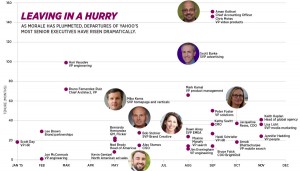By Sam Becker
With the pandemic mostly behind us, U.S. companies are slowly rolling out return-to-office mandates for many white-collar workers. In fact, 90% of them plan to implement such policies by the end of next year, according to an August survey from Resume Builder.
For employers, getting workers back into physical offices largely circles around productivity concerns. For workers—millions of whom have effectively proven they can do their jobs remotely and unsupervised—many don’t see the point, and may feel that they’re being asked to sacrifice time and money to commute for little to no benefit. And those sacrifices may be too much for some segments of the workforce to bear—the older portion, specifically.
As many as 25% of workers over the age of 50 say that return-to-office mandates made it more likely that they’ll retire, according to recent survey data from Carewell, a company that sells health and wellness products for at-home care. The data—generated from a survey of 523 American workers over the age of 50—also found that, on the contrary, 43% would be less likely to retire if they could work remotely.
And in a day and age in which the labor market and overall economy continue to show unexpected strength—the latest jobs report for September showed that the economy added 336,000 jobs, and the latest GDP data showed the economy growing at 4.9%—labor is a hot commodity. Though claims of a “labor shortage” have seemingly died down, workers still appear to have some negotiating power in the market, and pushing out a portion of them via return-to-office mandates could put employers at a disadvantage in the battle for talent.
That may, however, be a part of a larger plan by employers to cut costs, experts say.
“The survey results are not surprising, as surveys of older workers for the past 40 years have shown that the most negative aspect of an older person’s work is their commute,” says Teresa Ghilarducci, a professor of economics and policy analysis at The New School. “In this great post-pandemic era of reorganization and experimentation, knowing that older people don’t like to commute, employers may be using the back-to-office mandate to screen out the employees they want and the ones they don’t—and it’s better for employers when employees quit rather than needing to fire them,” she says.
It boils down to the fact that older workers tend to be more expensive than younger ones. They usually have higher salaries and higher healthcare costs, and if they can be replaced with cheaper, younger workers, doing so may help the bottom line for many companies. “It’s a once-in-a-lifetime chance to winnow out older workers without facing age discrimination lawsuits,” Ghilarducci says.
Interestingly enough, other experts are hearing otherwise from employers. Laura Putnam, a workplace well-being expert, says that she’s worked with hundreds of employers, and company leadership is experiencing resistance for return-to-office mandates—but from a different segment of the workforce.
“What I’m hearing from leaders is that they’re experiencing more pushback from people in the middle—people with younger families,” she says. This makes sense, as workers in their thirties and forties often have young children, additional time constraints, and childcare costs to contend with—something that Ghilarducci also mentions.
Meanwhile, Putnam says that, in her experience, workers who skew younger or older have different aims. “People fresh out of college really want to get into the office, and people in their fifties also want to get back into the office,” she adds, as many of the older workers she’s spoken with are often lonely working remotely. While there are a lot of things to consider—different industries, geographic areas of the country, and cultural differences, for instance—there are both positives and negatives to bringing people back into the office.
“It’s really a battle of perceptions around what people say they want,” Putnam says.
A reason to RTO
But what it ultimately comes down to is whether employers can justify bringing workers back into physical workspaces, when doing so costs workers time and money to commute. So far, employers have by and large not been able to put together a solid, cohesive reason or logic for doing so.
For older workers, the ask may simply be too much. “All we see is a situation in which employers need to pay higher wages and improve working conditions,” says Ghilarducci. While there has been some improvement from employers on that front, it hasn’t been enough, and as a result, “there’s a lot of excess labor sitting on the sidelines.”
Putnam adds that pushing out experienced workers in their forties, fifties, and sixties in order to save on payroll costs may make sense for employers from a mathematical perspective, but they’re offloading a lot of talent and experience that is hard to quantify—which they may end up regretting in the long term.
At the end of the day, the employers who want their workers back in cubicles or conference rooms around the country will need to make more of an effort—and give workers, young and old, solid logic for having to resume the commute.
Return-to-office mandates “do look like they’re good for companies’ bottom lines, and good for workers” in some respects, Putnam says. “But I’m seeing a lot of employers thinking that free food and T-shirts or happy hours are going to successfully lure people back to the office.”
“What’s going to work is to give people a good reason to come back,” she says.
(21)
Report Post








